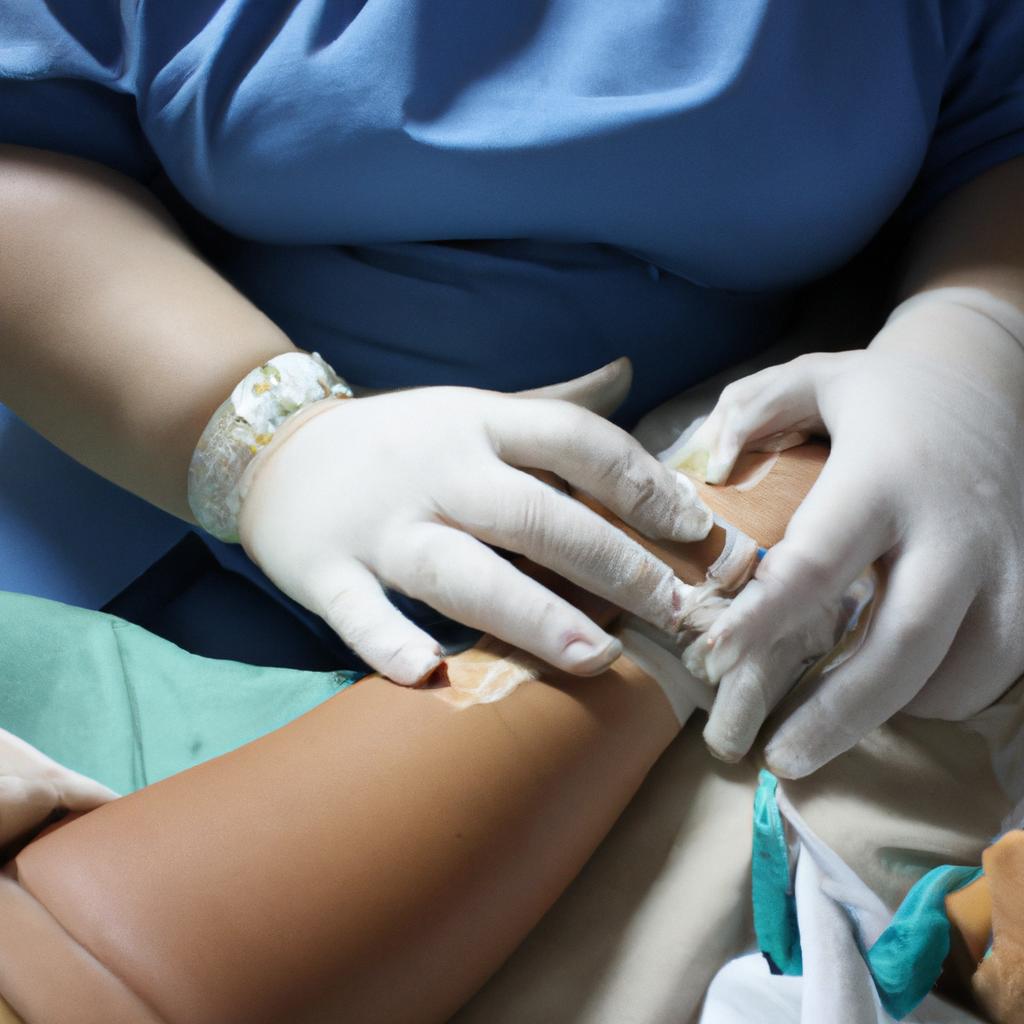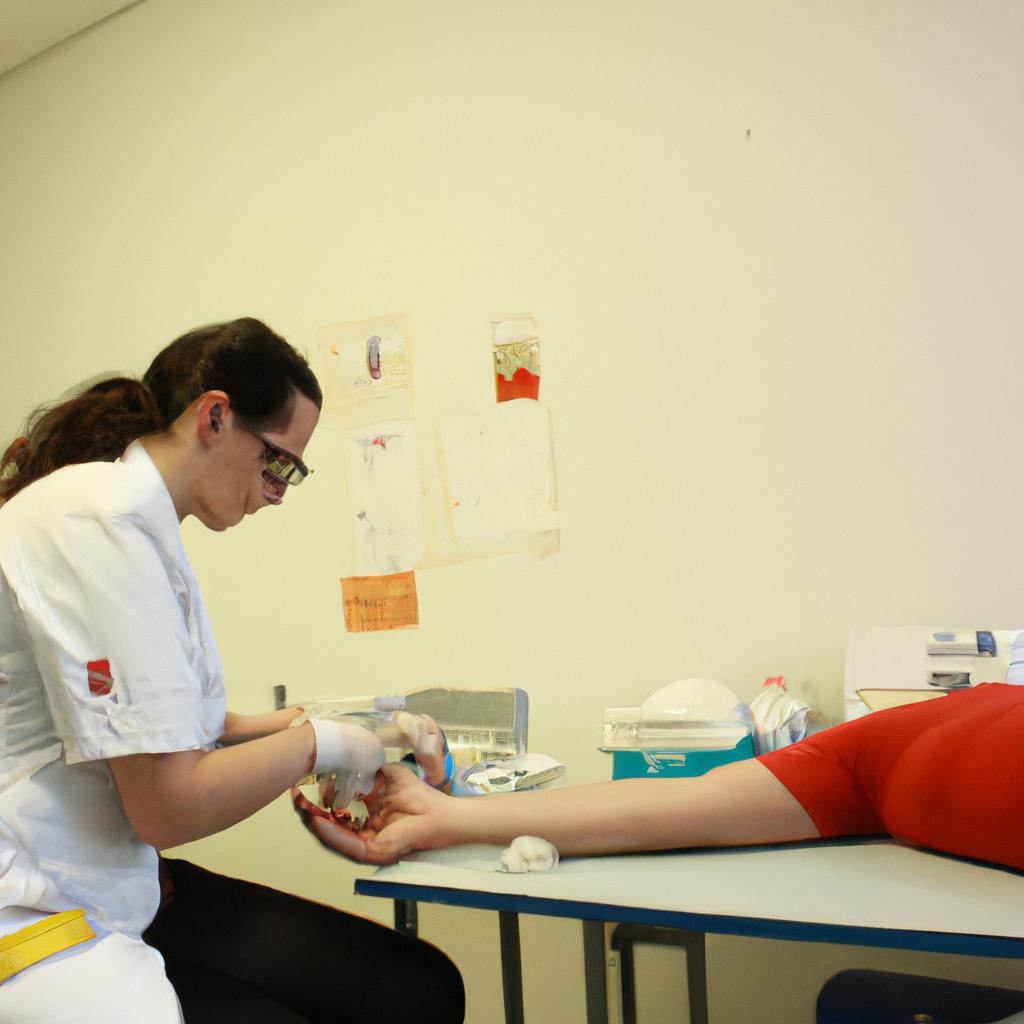Muscle Weakness in Body Myositis: Insights into Juvenile Myositis

Muscle weakness is a common symptom in patients with body myositis, particularly among those diagnosed with juvenile myositis. This autoimmune disorder affects the muscles and leads to inflammation, resulting in muscle weakness and fatigue. Understanding the underlying mechanisms of muscle weakness in body myositis is crucial for developing targeted treatment strategies and improving patient outcomes.
For instance, let us consider the case of a hypothetical adolescent named Sarah who was recently diagnosed with juvenile myositis. As she began experiencing progressive muscle weakness, her daily activities became increasingly challenging. Simple tasks such as walking up stairs or lifting objects became arduous endeavors. Such experiences highlight the impact of muscle weakness on individuals’ quality of life and underscore the significance of investigating its etiology in order to develop effective interventions.
This article aims to provide insights into the complex nature of muscle weakness associated with body myositis, focusing specifically on juvenile cases. By exploring potential contributing factors such as immune dysregulation and abnormal muscle metabolism, we aim to shed light on this debilitating symptom and pave the way for future research directions that may ultimately lead to better management strategies for affected individuals.
What is Muscle Weakness?
Muscle weakness is a common symptom of body myositis, a group of chronic inflammatory muscle diseases that primarily affect the skeletal muscles. It is characterized by progressive and symmetric muscle weakness, leading to difficulties in performing everyday tasks such as climbing stairs or lifting objects. To better understand the impact of muscle weakness in this condition, let us consider an example:
Imagine a 10-year-old child named Emma who was diagnosed with juvenile dermatomyositis, a subtype of body myositis. She used to be an active participant in sports and enjoyed playing soccer with her friends. However, over the past few months, Emma has noticed a significant decline in her strength and endurance. Now even walking short distances can be exhausting for her.
The experience of muscle weakness can have profound effects on individuals like Emma. Here are some key emotional responses often associated with this symptom:
- Frustration: The inability to carry out simple tasks due to weakened muscles may lead to frustration and feelings of helplessness.
- Anxiety: Concerns about further deterioration in physical abilities can cause anxiety and worry about future limitations.
- Isolation: Muscle weakness may result in reduced participation in social activities, leading to feelings of isolation and loneliness.
- Loss of independence: Dependence on others for assistance with daily activities can undermine one’s sense of autonomy.
To provide a visual representation, we present the following table highlighting various emotional responses commonly experienced by individuals dealing with muscle weakness:
| Emotional Response | Description |
|---|---|
| Frustration | Feeling annoyed or upset when unable to accomplish tasks due to weakened muscles |
| Anxiety | Experiencing worry or fear about potential worsening of physical abilities |
| Isolation | Feeling disconnected from social interactions due to limited mobility |
| Loss of Independence | Dependence on others for assistance leading to diminished sense of self-sufficiency |
In summary, muscle weakness is a prominent feature observed in body myositis patients, such as Emma. It can have significant emotional and psychological implications, including frustration, anxiety, isolation, and a loss of independence. Understanding these effects is crucial in providing comprehensive care for individuals affected by this condition.
Moving forward, we will explore the potential causes underlying muscle weakness in body myositis. By delving into the factors contributing to this symptom manifestation, we can gain further insights into its management and treatment strategies.
Causes of Muscle Weakness in Body Myositis
Insights into Muscle Weakness in Body Myositis
Muscle weakness is a defining characteristic of body myositis, particularly in juvenile cases. Understanding the underlying causes and mechanisms behind this symptom is crucial for effective diagnosis and management. In this section, we will delve deeper into the various factors that contribute to muscle weakness in body myositis.
To illustrate the impact of muscle weakness, let us consider an example: a 12-year-old patient named Emily who was recently diagnosed with juvenile dermatomyositis (JDM), a subtype of body myositis. Prior to her diagnosis, Emily had been actively participating in sports and dance classes without any notable limitations or discomfort. However, as the disease progressed, she began experiencing progressive muscle weakness and fatigue. This hindered her ability to perform daily activities such as climbing stairs or even lifting objects, eventually leading to significant functional impairment.
The development of muscle weakness in body myositis can be attributed to several key factors:
- Inflammation: Chronic inflammation within the muscles plays a central role in causing muscle damage and subsequent weakness. The immune system mistakenly targets healthy muscle tissue, resulting in cellular destruction and impaired muscular function.
- Muscle fiber degeneration: As the disease progresses, ongoing inflammation leads to the breakdown of muscle fibers. This not only impairs their contractile capacity but also affects their regenerative abilities, further exacerbating muscle weakness.
- Autoantibodies: Patients with body myositis often have autoantibodies circulating within their bloodstream that specifically target components of skeletal muscles. These autoantibodies promote direct damage to muscle cells and interfere with normal cell signaling processes involved in maintaining optimal muscular strength.
- Altered energy metabolism: Within affected muscles, there may be disruptions in energy production pathways due to mitochondrial dysfunction or impaired glucose utilization. Such metabolic abnormalities can compromise overall muscle performance and result in increased fatigue and weakness.
To better understand the impact of muscle weakness in body myositis, consider the emotional toll it takes on patients and their families:
- Frustration: The inability to perform once simple tasks can be frustrating and demoralizing for individuals with body myositis.
- Dependency: Muscle weakness often necessitates dependency on others for daily activities, leading to a loss of independence and potential feelings of helplessness.
- Social isolation: Impaired mobility may limit social interactions, resulting in feelings of loneliness and isolation.
- Emotional distress: Coping with chronic illness, along with its associated physical limitations, can lead to emotional distress such as anxiety or depression.
In summary, muscle weakness is a prominent feature in body myositis, significantly impacting patients’ quality of life. Its development stems from various factors including inflammation, muscle degeneration, autoantibodies, and altered energy metabolism. Understanding these mechanisms allows healthcare providers to offer targeted interventions that aim to alleviate symptoms and improve overall well-being. In the upcoming section about “Signs and Symptoms of Muscle Weakness,” we will explore how this symptom manifests clinically without further ado.
Signs and Symptoms of Muscle Weakness
Understanding the Causes of Muscle Weakness
Muscle weakness is a hallmark symptom of body myositis, with various underlying factors contributing to its development. One case study that exemplifies this is the 14-year-old patient, Sarah, who presented with progressive muscle weakness and difficulty rising from a seated position. Her medical history revealed no previous instances of trauma or infection.
Multiple mechanisms have been identified as potential causes for muscle weakness in body myositis:
- Inflammatory response: Inflammation plays a crucial role in the pathogenesis of body myositis. It leads to infiltration of immune cells within the muscle tissue, resulting in damage to muscle fibers and subsequent weakness.
- Autoimmune dysfunction: Abnormalities in the immune system can trigger an autoimmune response against specific components of muscle tissue, leading to inflammation and muscle fiber destruction.
- Genetic predisposition: Certain genetic variations have been associated with an increased susceptibility to developing body myositis. These variations may affect key molecular pathways involved in maintaining healthy muscles.
- Environmental triggers: Environmental factors such as infections or exposure to certain toxins may act as triggers for the onset or exacerbation of body myositis symptoms.
To further illustrate these causes, consider the following table presenting key insights into their contributions:
| Cause | Mechanism |
|---|---|
| Inflammatory Response | Immune cell infiltration damages muscle fibers |
| Autoimmune Dysfunction | Immune system attacks components of muscle tissue |
| Genetic Predisposition | Variations affecting molecular pathways |
| Environmental Triggers | Infections or toxin exposure triggering symptoms |
This brief overview highlights some common causes behind muscle weakness observed in individuals with body myositis. By understanding these underlying factors, healthcare providers can better tailor treatment strategies to address the specific needs of each patient.
Moving forward, it is crucial to explore the signs and symptoms associated with muscle weakness in body myositis.
Continue reading about ‘Signs and Symptoms of Muscle Weakness’
Diagnosing Muscle Weakness in Body Myositis
Muscle Weakness in Body Myositis: Insights into Juvenile Myositis
Signs and Symptoms of Muscle Weakness
Imagine a young girl named Emily who enjoys playing soccer with her friends. However, lately, she has been experiencing difficulty keeping up with them on the field. Despite her best efforts, her legs feel heavy and weak, making it challenging for her to run as fast or kick the ball as far as she used to. This scenario is just one example of how muscle weakness can manifest in individuals affected by body myositis.
When it comes to muscle weakness in juvenile myositis, several signs and symptoms may be present:
- Progressive loss of muscle strength: Patients often notice a gradual decline in their ability to perform everyday tasks that require muscle power, such as climbing stairs or lifting objects.
- Fatigue: Muscle weakness can lead to increased fatigue during physical activities, even ones previously accomplished without any difficulties.
- Difficulty swallowing: In some cases, weakened muscles can affect the function of the throat muscles, leading to dysphagia (difficulty swallowing).
- Respiratory problems: If respiratory muscles are involved, patients may experience shortness of breath or other breathing difficulties.
Diagnosing Muscle Weakness in Body Myositis
To determine if someone’s muscle weakness is due to body myositis specifically, healthcare professionals rely on various diagnostic methods:
| Diagnostic Methods | Description |
|---|---|
| Physical examination | A thorough evaluation by a physician includes assessing muscle strength and mobility through specific movements and resistance tests. |
| Blood tests | Levels of certain enzymes associated with muscle inflammation (such as creatine kinase) may be elevated in blood samples from those with body myositis. Other antibodies related to autoimmune disorders could also be tested for identification purposes. |
| Electromyography | By measuring electrical activity within muscles using a needle electrode, electromyography helps identify abnormal muscle function and differentiate between different types of myositis. |
| Muscle biopsy | A small sample of muscle tissue is taken for microscopic analysis to confirm the presence of inflammation and specific changes characteristic of body myositis. |
These diagnostic methods serve as essential tools in identifying the underlying causes responsible for muscle weakness in individuals suspected of having juvenile myositis.
Moving forward, we will explore treatment options available to manage muscle weakness associated with body myositis. By understanding these interventions, patients can take proactive steps towards improving their quality of life while combating this debilitating condition.
Treatment Options for Muscle Weakness
Understanding the underlying causes and manifestations of muscle weakness in body myositis is crucial for effective diagnosis and treatment. By examining specific case studies, we can gain valuable insights into this debilitating condition that primarily affects children and adolescents.
For instance, consider a hypothetical scenario where a 10-year-old girl named Emily presents with progressive muscle weakness, fatigue, and difficulty performing daily activities. After thorough evaluation by medical professionals, she is diagnosed with juvenile dermatomyositis (JDM), a subtype of body myositis commonly affecting children below the age of 18. This case highlights the urgent need to comprehend the intricacies surrounding muscle weakness in JDM to offer appropriate interventions.
To delve deeper into understanding muscle weakness in body myositis, let us explore some key factors:
- Inflammatory response: Inflammation plays a pivotal role in causing muscle damage and subsequent weakness in body myositis. The immune system mistakenly attacks healthy tissues, leading to chronic inflammation within muscles.
- Muscle fiber abnormalities: In individuals affected by body myositis, microscopic examination often reveals characteristic features such as infiltration of immune cells within muscle fibers and degeneration/regeneration cycles.
- Protein dysregulation: Research indicates that abnormal expression or dysfunction of certain proteins involved in muscle structure and function may contribute to the pathogenesis of muscle weakness in body myositis.
- Autoantibodies: Autoimmune responses triggered by unknown factors result in the production of autoantibodies targeting components within muscles. These autoantibodies further exacerbate inflammation and lead to additional tissue damage.
Table – Factors Contributing to Muscle Weakness
| Factor | Description |
|---|---|
| Inflammatory Response | Chronic inflammation leads to muscle damage |
| Muscle Fiber Abnormalities | Immune cell infiltration and degeneration/regeneration cycles |
| Protein Dysregulation | Abnormal expression or dysfunction of muscle proteins |
| Autoantibodies | Production of autoantibodies targeting muscle components |
Understanding these underlying factors is essential not only for accurate diagnosis but also for developing targeted treatment strategies. By comprehending the intricate mechanisms driving muscle weakness in body myositis, researchers can work towards finding novel therapeutic approaches that specifically target these pathways.
Transitioning into the subsequent section on “Prevention and Management of Muscle Weakness,” it becomes evident that a comprehensive understanding of the factors contributing to muscle weakness is crucial for formulating effective preventative measures and management strategies.
Prevention and Management of Muscle Weakness
In the previous section, we discussed various treatment options for muscle weakness in body myositis. Now let’s delve into the crucial aspects of preventing and managing this debilitating condition.
To illustrate the significance of prevention, consider a hypothetical case study involving a young individual diagnosed with juvenile myositis. This patient, despite receiving appropriate treatment for their initial symptoms, unfortunately experiences recurring episodes of muscle weakness. These relapses not only hinder their physical abilities but also impact their emotional well-being, leading to feelings of frustration and isolation.
Preventing or minimizing these relapses requires a comprehensive approach that encompasses both medical interventions and lifestyle modifications. Here are some key strategies to consider:
- Medication adherence: Ensuring strict compliance with prescribed medications is essential for managing muscle weakness effectively.
- Regular exercise program: Engaging in structured exercises tailored to an individual’s capabilities can help improve muscle strength and function.
- Balanced diet: Consuming a nutritious diet rich in protein, vitamins (particularly vitamin D), antioxidants, and omega-3 fatty acids supports overall muscular health.
- Stress management techniques: Implementing stress-reducing activities such as meditation or yoga may contribute to better control over muscle weakness flare-ups.
Table: Emotional Impact of Muscle Weakness
| Emotions | Physical Manifestations | Coping Strategies |
|---|---|---|
| Frustration | Increased fatigue | Seek support from loved ones |
| Isolation | Difficulty performing tasks | Join local support groups |
| Anxiety | Decreased mobility | Practice relaxation techniques |
| Depression | Impaired quality of life | Seek professional counseling |
By addressing these preventive measures proactively, individuals living with muscle weakness due to body myositis can experience enhanced physical functioning while simultaneously improving their emotional well-being. It is important to recognize that effective prevention and management strategies require a multidisciplinary approach involving healthcare providers, patients, and their support systems.
In summary, understanding the importance of prevention and implementing appropriate management techniques can significantly alleviate the burden of muscle weakness in body myositis. By adhering to medication regimens, maintaining an active lifestyle, following a balanced diet, and managing stress levels, individuals can empower themselves to lead fulfilling lives despite this challenging condition.






